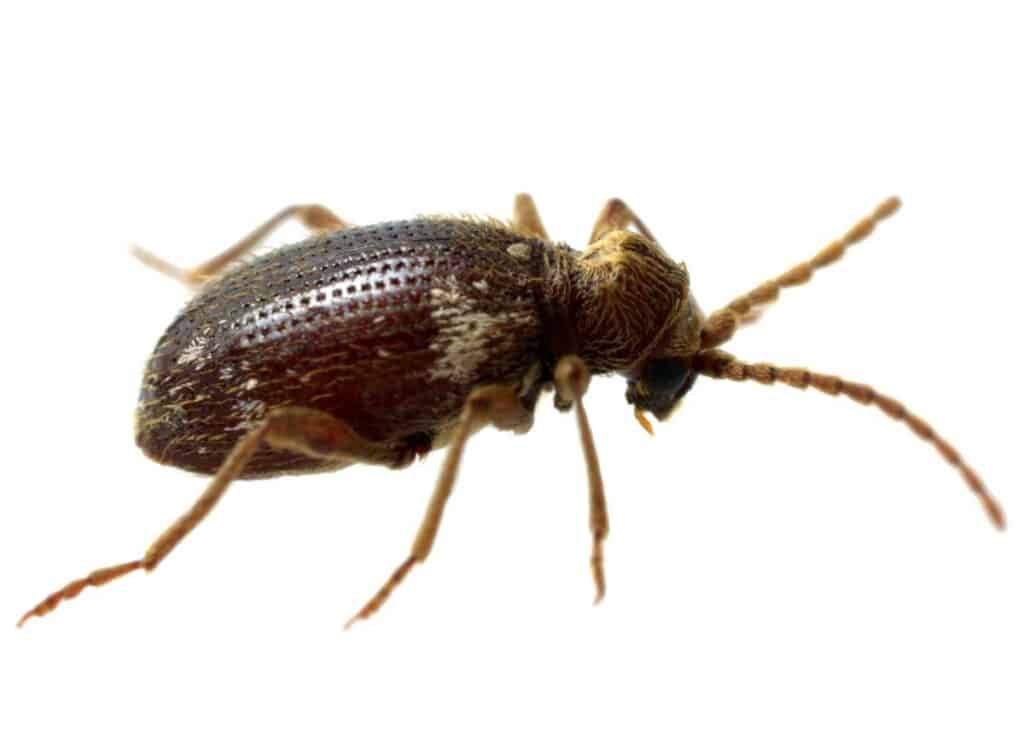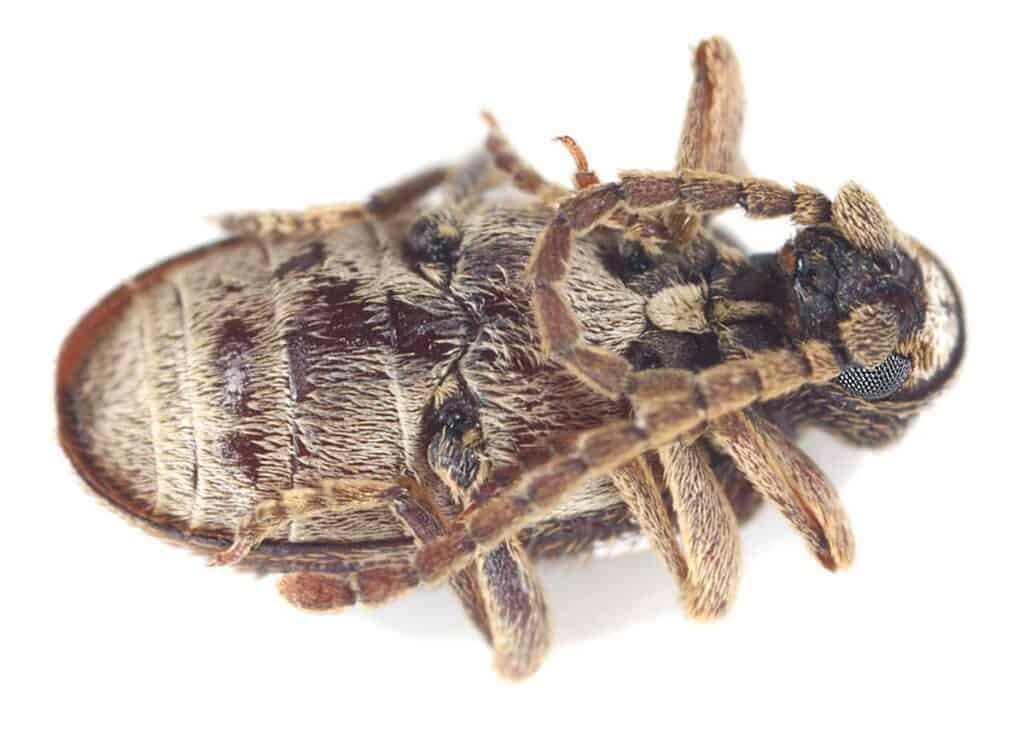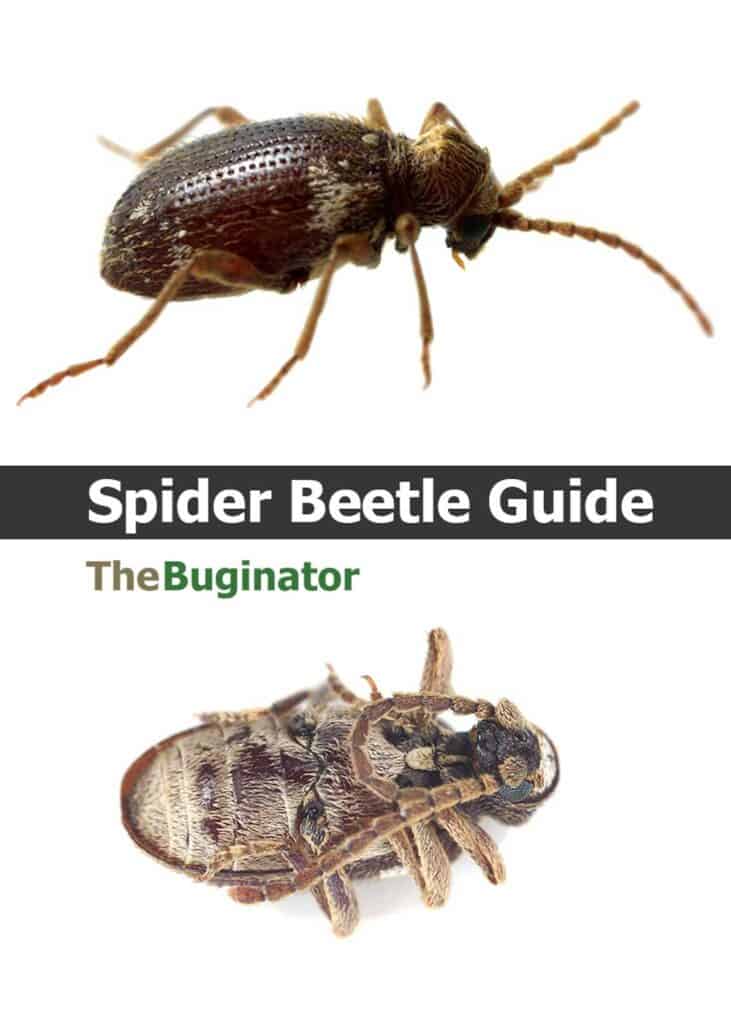Is it a spider? Is it a beetle? This is the question posed by people who see the spider beetle creeping around their kitchen, and to be sure, it’s a funny little critter. Let’s talk about spider beetles and how to identity, locate, and exterminate them.

Table of Contents
Spider Beetle Facts
- Scientific name: Mezium americanum
- Common name: Spider beetle, American spider beetle, black spider beetle
- Size: 1.5 – 3.5 millimeters
- Geographic region: America
- Habitat: Warm and moist environments
- Diet: Food products, especially old or moldy food products that have expired
- Appearance: Brown- or red-black bodies with long and spindly legs
Spider Beetle FAQ
What do spider beetles look like?
Spider beetles are small, generally measuring between 1.5 – 3.5 millimeters long. Depending on the species, their bodies can range from yellow to brown to reddish-black in color.
They get their name from the fact that they look a lot like spiders with plump, oval bodies and two long antennae to go along with their six legs.
At a glance, they seem to be eight-legged creatures!
Do only spiders have 8 legs? Learn about 11 types of 8-legged animals.

How many types of spider beetles are there?
There are a staggering 600 species of spider beetle. They’re all found within the Ptininae subfamily, but there are specific names for specific breeds.
The American spider beetle is called Mezium americanum.
What’s the natural range of spider beetles?
Spider beetles are found all over the world.
They’re often classified according to location, such as Pseudeurostus hilleri (the Japanese spider beetle) and Mezium americanum (the American spider beetle).
What do spider beetles eat?
Spider beetles live on foodstuffs, including beans, nuts, powders, grains, herbs, and cereals.
They’re opportunistic scavengers who are often found in kitchens and other food preparation sites.
In addition to “real” food, they’ve also been known to feed on things like leather, fur, hair, old wood, dead insects, and even feces.
Where do spider beetles live?
In the wild, spider beetles live in nests, burrows, and other dark and moist places. In urban areas, they tend to congregate in restaurants, supermarkets, mills, warehouses, and other buildings where old or discarded food sources are apparent.
They aren’t usually a household pest, but they can hitch a ride in things like fruit crates and bags of flour, so it isn’t unheard of for spider beetles to start breeding inside home kitchens and pantries.
Because of their appearance, it’s easy to see why they might be mistaken as a spider. Here are 9 common house spiders.
How often do spider beetles mate?
Spider beetles can mate several times per year, and the females can lay up to 120 eggs each time, so it’s important to act quickly if you think that you have an infestation.
The larvae of all three species are “C” shaped and cream colored with light brown heads. The length is dependent on the age of the larvae but can reach 3.5 to 4 millimeters.
College of Agricultural Sciences, PennState Extension
Where do spider beetles lay their eggs?
Spider beetles eat and breed in the same places. They’ll mate, lay their eggs, and hatch their larvae in food, trash, empty nests, and other unsavory places.
Do spider beetles bite?
American spider beetles aren’t known to bite. They only feed on food, hair, and waste products, so they have no reason to bother with humans.
In fact, since they’re nocturnal scavengers, you’ll probably scatter them as soon as you turn on a light!
Are spider beetles dangerous?
Spider beetles aren’t particularly dangerous. They don’t bite, and they don’t transmit any known diseases.
That said, they can be a very annoying pest, and they can contaminate large quantities of food if they make their way inside bags, boxes, or crop stores.
If you see just one spider beetle in a bag of flour, for example, it’s best to throw the whole thing away.
There might be more adults feeding within it, and there might be unseen larvae living in it, too.
Why do spider beetles come inside the house?
Spider beetles are attracted to food, including food waste, so they’ll follow their noses into kitchens, dumpsters, pantries, and general storage areas for foodstuffs.
They’ve also been known to take over bird and rodent nests, so if you have any of those in your attic, you might turn into an unwilling host to spider beetles.

Learn more about other small black, biting bugs.
How to Get Rid of Spider Beetles: 5 Methods
There are a few ways to get rid of spider beetles. Some are preventative; others are focused on extermination.
You might have to experiment with different methods to find the ones that work for you.
- Keep your kitchen and garbage areas clean. Empty your trash regularly; don’t leave your bread products untied; don’t let fruits and veggies rot on your countertops.
- Sweep or vacuum on a regular basis. Make sure to get crumbs, dirt, dust, hair, fur, droppings, and anything else that spider beetles see as a snack.
- Use essential oils. Strong and minty smells can act as a deterrent to spider beetles, including peppermint. Mix them with water and spray them liberally around your pantries. Avoid anything that smells sweet and could be mistaken as a food source.
- Spray an insecticide. You might need beetle-specific insecticides since beetles can be resistant to the low-grade bug sprays that work on ants and mosquitos.
- Create barriers with diatomaceous earth. Diatomaceous earth is an all-natural powder that you can sprinkle around the borders of homes and gardens. It will cut and dry out the spider beetles as they move across it.
More reading: 15 Easy Ways to Get Rid of Spiders
Dealing With Spider Beetles
You don’t have to live with spider beetles. If you’ve noticed them crawling around your kitchen, you can identity them, find their feeding and breeding grounds, and start exterminating them with impunity. They might have a cool name, but they aren’t cool houseguests!
- About the Author
- Latest Posts
Bryan Haines is a co-founder and writer at The Buginator. And is working to make it the best resource for taking back the outdoors from biting, stinging pests.
He also blogs about travel at Storyteller.Travel and photography at Storyteller Tech. Bryan is a partner at Storyteller Media, a publishing company he runs with his wife, Dena.
